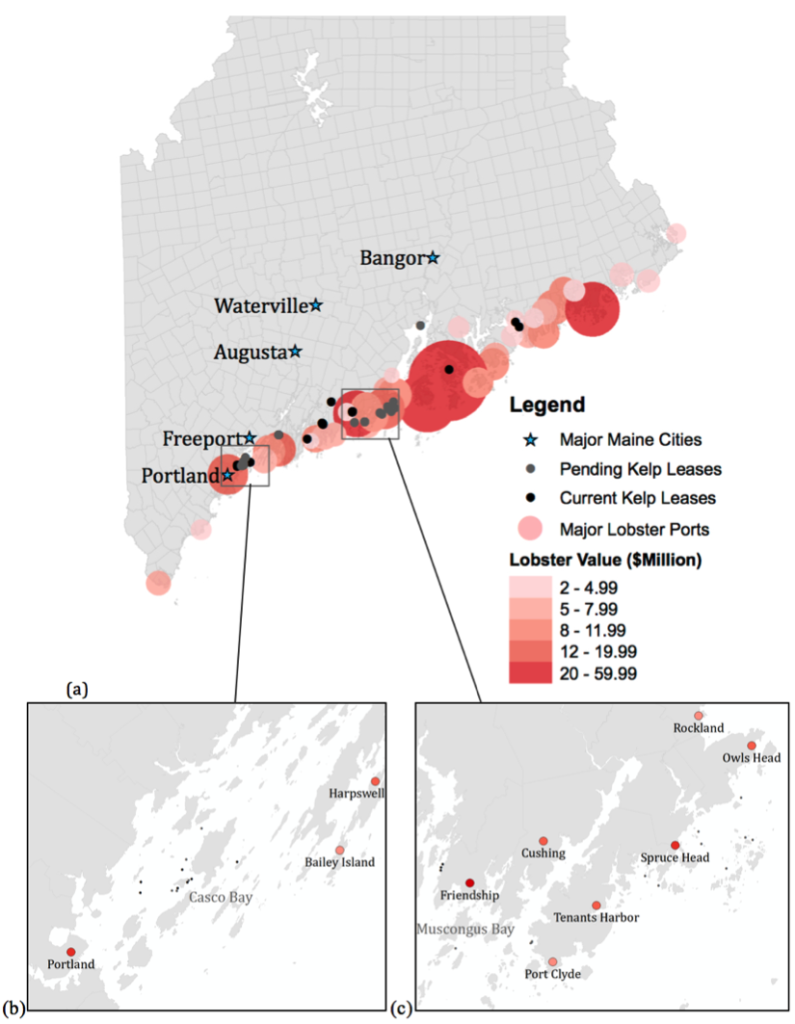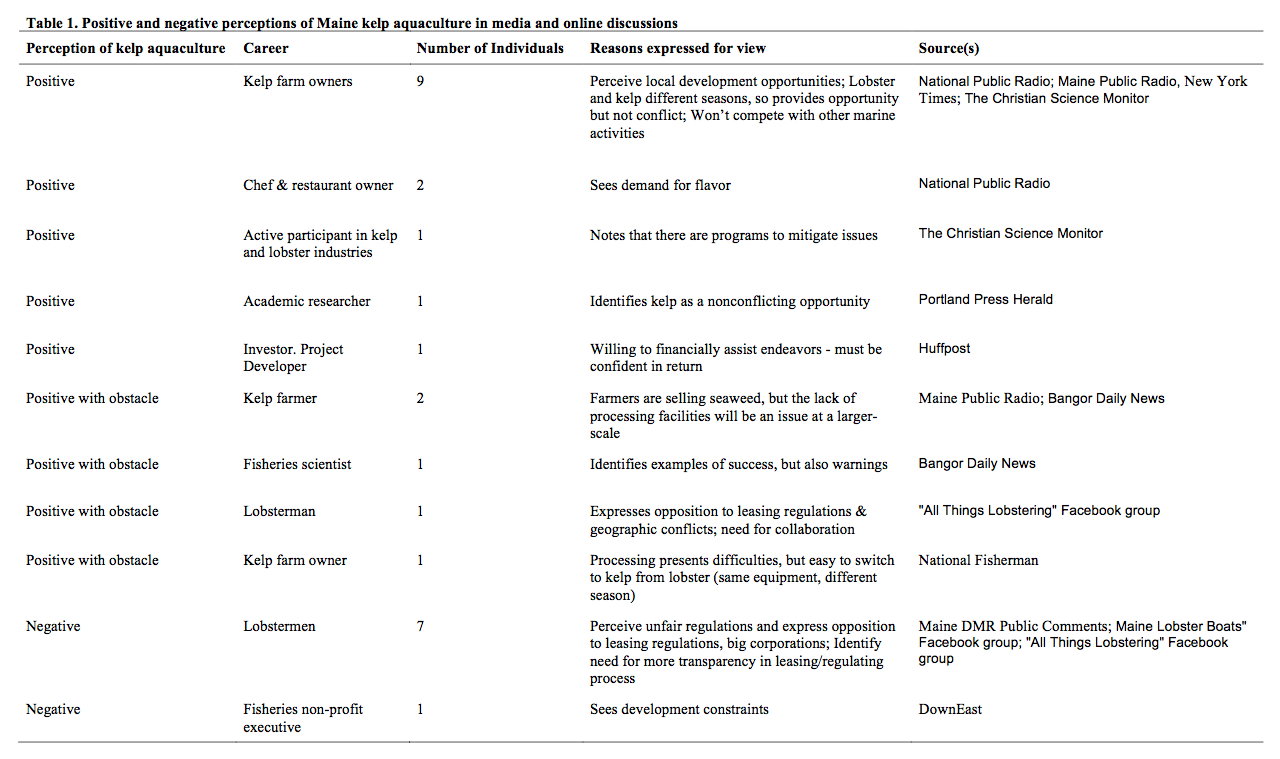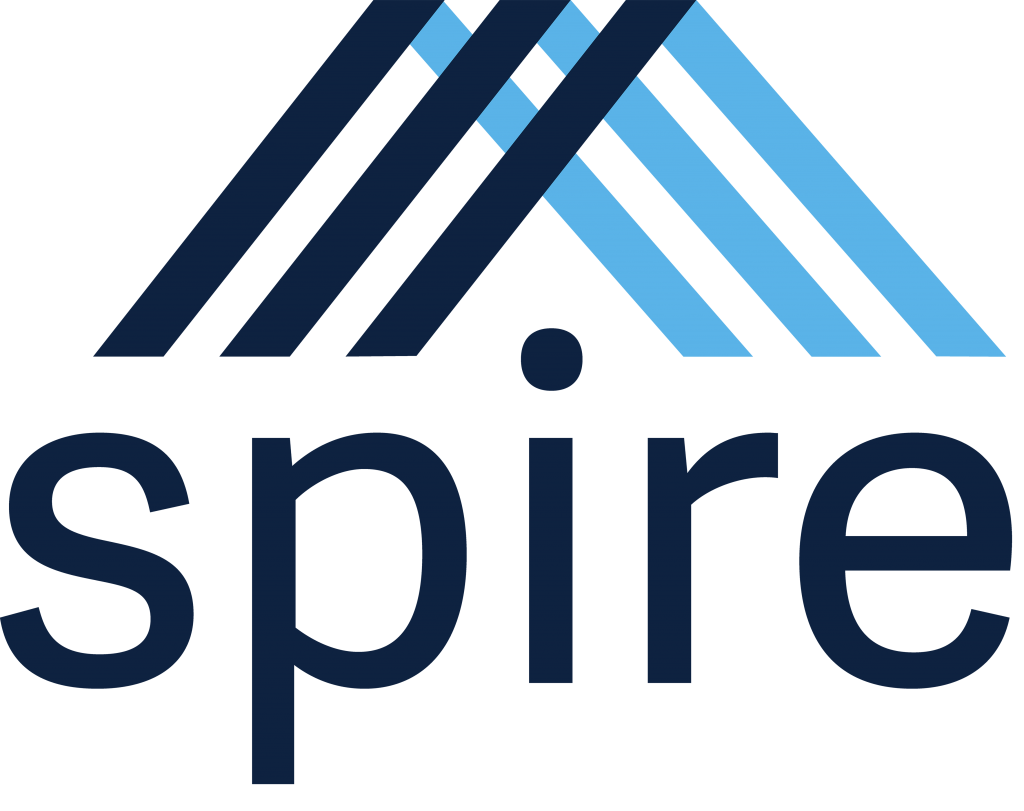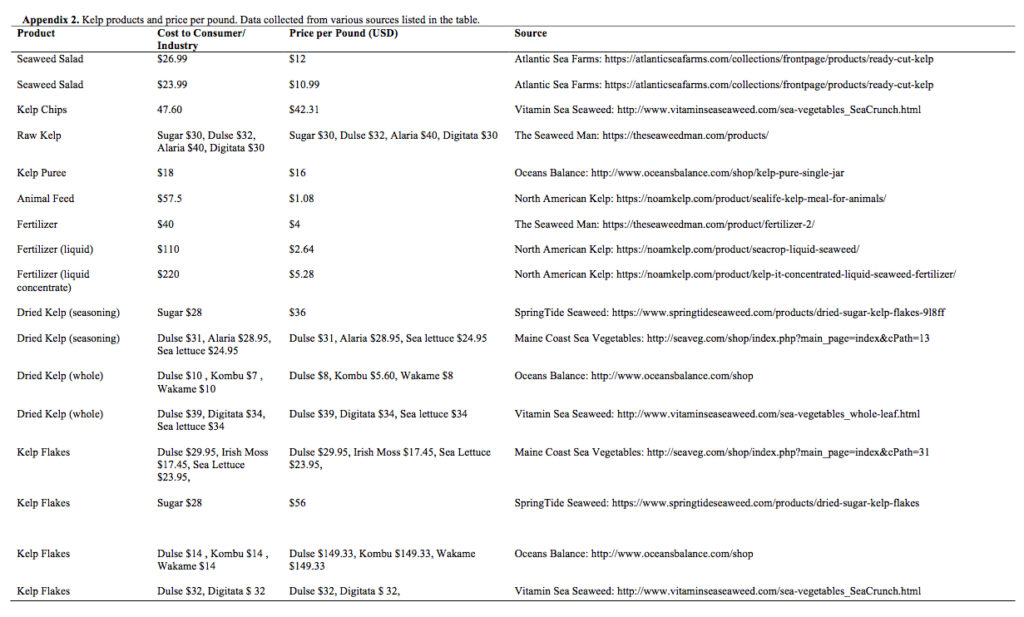Diversifying Maine’s coastal economy: A transition from lobster fishing to kelp aquaculture?
Madeline Greene1, Mae Sefransky1, Christopher Wang1, Loren McClenachan2,‡
1Colby College Environmental Studies Program
2Associate Professor of Environmental Studies, Colby College, Waterville ME
‡Corresponding Author. Email: loren.mcclenachan@colby.edu
Abstract
Since the early 20th century, Maine has relied heavily on the lobster industry for its contributions to both the state economy and identity. However, the high dependence on lobster has turned the fishery into a gilded trap, or a valuable monoculture, that is vulnerable to the effects of climate change. Therefore, Maine coastal communities are starting to think about economically and socially viable alternatives, such as kelp aquaculture. This paper seeks to determine kelp’s potential to diversify Maine’s coastal economy, specifically asking the questions: (1) Geographically, where along Maine’s coast is a transition from lobster fishing to kelp aquaculture most likely to take place?; (2) What is the current and potential future economic value of kelp aquaculture to Maine’s coastal economy?; and (3) How are key stakeholders in Maine’s coastal communities responding to kelp aquaculture as a potential primary Maine industry? To address these questions, we collected spatially explicit data on current kelp and lobster value, conducted expert interviews to identify potential for future growth, and completed a media analysis to determine social perceptions of kelp aquaculture and individuals and institutions involved in this transition. We found that the overlap of existing fisheries infrastructure has supported a hotspot of transition in South Central Maine. The rate of kelp aquaculture production is predicted to increase from the current rate of 6.75% a year, with projected annual retail values of $2.2 million, though this growth is dependent on developments of processing facilities. Finally, we identified key individuals and institutions involved in the transition from lobster to kelp, indicating that this economic diversification is underway. While our results demonstrate that kelp has the potential to be economically and socially beneficial to Maine’s economy, they also indicate that continued injections of social and economic resources are needed for kelp to mirror the success of the Maine lobster industry.
Keywords: Maine, lobster, kelp, aquaculture, coastal economy diversification, environmental attitude, stakeholder involvement
Introduction
Wild-caught lobster is one of Maine’s top enterprises; 80% of lobster in the United States come from Maine’s adjacent waters (Holland 2011). In 2018 the lobster industry brought in approximately $500 million to Maine’s economy, accounting for more than three quarters of the yearly value for the state’s commercially harvested marine resources (Maine DMR 2019). The lobster industry is estimated to create over 35,000 jobs on the working waterfront; in addition to the 4,500 state licensed lobstermen, the industry supports lobster dealers and processors, those involved with boat maintenance, and seasonal restaurant workers (Collins 2018). Involvement in the industry offers not only stable and secure employment, but a sense of purpose, community, and belonging for much of Maine’s coastal population. Moreover, lobster has become a state icon with an international reputation that plays an important role in attracting millions of visitors and perpetuating the small-town, family-owned character of Maine (Lewis 1989). Tourists flock to the state to enjoy lobster meat, and many also seek an authentic “Maine experience,” attracted to the charm of historic fishing villages. Festivals, like the Rockland Lobster festival, celebrate the lobstering culture and fundraise for coastal communities (Claesson et al. 2005), and some Maine lobstermen have even begun offering boat tours to tourists interested in the fishing process (Melendez 2019).
However, this dependence on lobster confers vulnerability, particularly with respect to warming waters associated with global climate change (Steneck et al. 2011). The poleward shifts of marine species have allowed lobsters to be successful in the Gulf of Maine, yet as warming events continue lobsters are predicted to move further north, and the Gulf of Maine population will become less predictable (Goode et al. 2019). These changes will alter the livelihood of those who are dependent on the industry (Barnett & Eakin 2015; Goode et al. 2019). For example, in 2012, the Northern Atlantic experienced a heatwave that increased surface temperatures roughly one to three degrees Celsius above the average. This warming event caused the quantity of lobster caught, landed, and available for market to peak before Maine tourist season, triggering a price drop of 70% below average per pound prices (Mills et al. 2013).
Diversifying the coastal economy is one strategy to avoid the negative impacts of declines in the lobster industry. Kelp aquaculture, though in the early stages of development, has shown great promise (Christian 2015). Around the world in countries like Canada, Chile, and Japan, the growth and integrations of seaweed into fed aquaculture systems have proven to be ecologically and economically beneficial (Chopin et al. 2002; Chopin et al. 2012; Kim et al. 2017). This industry is growing in Maine, but there is limited research regarding the economic and social viability of a kelp industry. Therefore, our research addresses three questions: (1) Geographically, where along Maine’s coast is a transition from lobster fishing to kelp aquaculture most likely to take place?; (2) What is the current and potential future economic value of kelp aquaculture to Maine’s coastal economy?; and (3) How are key stakeholders in Maine’s coastal communities responding to kelp aquaculture as a primary Maine industry?
Methods
First, we conducted a spatial analysis in order to determine the overlap of the kelp and lobster industries and identify places where kelp is most likely to act as substitute for the lobster fishery. To do this, we used Maine Department of Marine Resources (DMR) data on the landed value of 2018 lobster for ports in Maine and the locations of current and pending kelp aquaculture leases (Maine DMR 2019). We determined the 40 most valuable lobster ports to be representative of the Maine lobster industry because they support nearly all of its total value (92.9%) and total lobster landing weight (92.7%). We mapped all current and pending kelp aquaculture leases and used these to identify areas where there were large and valuable lobster ports adjacent to clusters of kelp sites.
Second, to determine the current economic value of the kelp industry, we gathered information from the Maine DMR on annual harvest, and combined this with information on price per pound, which we identified from online sales of processed and industrial kelp products in the state of Maine. Using web searches, we compiled a database of the companies, the types of products, and the product prices, which we transformed into a price per pound measurement and averaged based on the type of product (consumer products versus industrial products). We defined consumer products as those that have added value through marketing towards household use, such as seaweed salad and kelp flakes. Industrial products included raw kelp, animal feed, and fertilizer. We converted wet pounds produced from kelp aquaculture reported to the Maine Department of Marine Resources (2015-2018) into dry pounds of kelp by using a ratio of ten wet pounds to one dry pound (Maine DMR 2019). Together with our price data, we estimated the consumer and industrial sales values of kelp. To determine the future potential economic value of the kelp industry in Maine, we interviewed experts in Maine kelp aquaculture, including marine scientists and policy professionals, asking questions regarding projections of kelp aquaculture production and factors that may limit or enhance production (Appendix 1). We used their responses to create projections of the kelp industry over the next ten years.
Finally, to determine the public’s view of kelp aquaculture — and in particular the view of current lobster fishers — we searched existing online databases for news publications relevant to the topic. Keywords included, but were not limited to, “kelp aquaculture, “Maine,” and “seaweed farming.” Information was found and taken from both state news sources (Maine Public Radio, Portland Press Herald) and national news sources (National Fisherman, National Public Radio). To expand the range of represented social groups we also joined a Facebook group, “All Things Lobstering,” and searched for comments about kelp made by Maine lobster fishers to other Maine lobster fishers. We noted relevant text from the source, our categorization of the individual as having a negative or positive view of kelp aquaculture, and what led us to interpret their comment as positive or negative. Additionally, we identified examples of lobster fishers transitioning to kelp aquaculture, and institutions and organizations noted in the media sources as having played a significant role in the research, education, and financial backing of kelp aquaculture endeavors.
Results
Hotspots of Transition
The distribution of Maine’s major lobster ports suggests that the lobster industry is influential across the entirety of the coast, but there are key ports of particular importance for Maine lobstermen (Figure 1). The two most valuable ports in Maine, Stonington and Vinalhaven, alone bring in nearly a fifth (19.66%) of Maine’s total lobster landing value. To the south is a cluster of valuable ports like Friendship, and Downeast Maine includes a number of other major ports, notably Beals. The Casco Bay region is also particularly important to the lobster industry as it was surrounded by a few important ports like Portland and Cundys Harbor, the fifth and seventh most valuable Maine lobster ports respectively.
The kelp industry meanwhile tends to be concentrated primarily in mid-coast Maine from Portland to Rockland. While there are a few kelp leases further north in the Penobscot River and Frenchman Bay, nearly all other kelp aquaculture sites are located in this central region. Within this region, we identified two major clusters of kelp aquaculture sites in Casco Bay in Cumberland County and in Knox County along Maine’s central coast. This was also where the large majority of pending leases were concentrated.
The greatest overlap between the industries exists in mid-coast Maine just south of Vinalhaven and Stonington, particularly in Knox and Cumberland Counties (Figure 1). These areas contain the highest concentrations of kelp aquaculture leases along the coast of Maine, combined with significant presence of lobster fishing, suggesting that this is the area where a transition may be underway.

Economic Viability of Kelp
Our economic analysis of kelp aquaculture indicates that the industry is growing rapidly. Harvest data from 2015-2018 show that kelp production has increased by 6.75% annually. Consumer marketed products have a substantially higher estimated value in comparison to industrial products , with average values of $40.81 per pound and $3.25 per pound, respectively (Figure 2a; Appendix 2).
Experts in the kelp aquaculture industry agreed that kelp production will increase at a rate greater than the current rate (+6.75% per year) over the next ten years (Figure 2b), and that available markets and locations available for growing kelp would help support this increased growth. However, the rate of growth is dependent on surpassing limitations including lack of processing capacity available to create marketable, value-added products. Despite these uncertainties, one expert predicted exponential growth resulting in a ten-fold increase in value in the next decade. This increase would propel kelp production to an estimated 53,560 dry pounds in 2028, which corresponds to a combined industrial and consumer value of $2.2 million. By comparison, the lobster industry in 2018 brought in $484.5 million in total dockside value.

Perceptions of Kelp Across Stakeholder Groups
Our media analysis indicated mixed views of kelp aquaculture by the Maine community. Of 20 recent news articles about kelp, we categorized eight as “positive,” four as “positive with obstacle,” and eight as “negative” (Table 1). “Positive with obstacle” denotes that the individual perceived the industry as promising, but mentioned a barrier necessitating further planning and development before it can reach its full potential. However, views vary across stakeholder groups. Seven out of eight of the individuals categorized as holding a negative view were lobster fishers; the eighth was a fisheries non-profit executive. Individuals with positive/positive-with-obstacle viewpoints hold a range of professions, from kelp farmers to fishery scientists, and chefs to project developers.

Despite mixed views, we identified multiple instances of lobster fishers who have begun kelp farming (Table 2), and an associated positive view of kelp aquaculture as a beneficial diversification strategy. All of these individuals are situated in Knox County and Cumberland Counties, including the towns of Damariscotta, Falmouth, Corea, Biddeford, Chebeague Island, and Saint George. Some of these lobstermen were aided by programs and institutions (Table 2); others may have had assistance in transitioning but did not mention it. These institutions have missions to research market structure, fund enterprises, and provide education, and include Coastal Enterprise Inc., Maine Sea Grant, National Oceanic and Atmospheric Administration, and the Island Institute (Appendix 3).

Discussion
Kelp aquaculture has the potential to help diversify Maine’s coastal economy, which will be necessary in an era of warming waters. While the current value of kelp is over orders of magnitude lower than the value of lobster, this sort of fisheries diversification is important to maintain resilience in fishing communities, particularly in times of change (Cline et al. 2017). In Maine, a diversity of institutions has invested in kelp aquaculture development, and future investments in kelp processing will help to create marketable products, which in turn will increase consumer demand. Locally-derived value added products like kelp chips and other dried kelp products have been popular, North America is projected to have the fastest growing kelp market, and growth of other uses in pharmaceutical and cosmetic industries is predicted to fuel market growth (Markets and Markets 2020). All of these trends are promising for Maine kelp production, though many unknowns exist.
While there is momentum toward the development of a kelp industry in Maine, there is also opposition to this industry from within the lobstering community. All of the negative views expressed in the media came from lobstermen, who objected to the influx of large corporations as well as unfair leasing practices. These competing claims of coastal access and resources among key stakeholders are important to acknowledge in designing inclusive solution-oriented plans for coastal development and fisheries diversification. Lobstermen’s concerns and requests must be taken seriously; transparency and assurance that kelp farms will not negatively impact the lobstering industry is critical to broader acceptance of aquaculture.
Importantly, our research also shows that kelp aquaculture by lobstermen has the potential for positive ripple effects. Casco Bay and Mid-coast Maine are places where fishermen are engaging with kelp aquaculture. This is seen both in the geographic overlap of the industries, as well as in the views expressed by lobster fishers who have transitioned to kelp. Casco Bay and Knox County have large numbers of pending kelp lease applications, suggesting that kelp aquaculture will continue to grow in these regions in the future. The shifts in views of lobster fishers in Knox County and Cumberland County in particular provide hope that there will be future acceptance, and growth, of kelp aquaculture.
Acknowledgments: We would like to thank the various individuals instrumental in conducting this project. Nick Battista, Dana Morse and Jaclyn Robidoux were all significant in understanding the future of the kelp industry in Maine.
References
Bank, David. “As Maine’s waters warm, a seafood investor fosters climate resiliency.” Huffpost, August 4, 2015. https://www.huffpost.com/entry/as-maines-waters-warm-a-s_b_7914988.
Bever, Fred. “Maine seaweed: the next super-food?” Maine Public Radio, April 26, 2016. https://www.mainepublic.org/post/maine-seaweed-next-super-food.
Bever, Fred. “Seaweed on your dinner plate: the next kale could be kelp.” National Public Radio, June 5, 2016. https://www.npr.org/sections/thesalt/2016/06/05/480346509/seaweed-on-your-dinner-plate-the-next-kale-could-be-kelp.
Bever, Fred. “As Maine’s coastal waters warm, lobstermen look to new fisheries for stable future.” Bangor Daily News, September 23, 2019. https://bangordailynews.com/2019/09/23/news/state/as-maines-coastal-waters-warms-lobstermen-look-to-new-fisheries-for-stable-future/.
Bever, Fred. “Sea-farmer hopes plans for Falmouth seaweed farm that would employ women in recovery garners support.” Maine Public Radio, April 19, 2019. https://www.mainepublic.org/post/sea-farmer-hopes-plans-falmouth-seawee d-farm-would-employ-women-recovery-garners-support-0.
Chopin, Thierry, Alejandro H Buschmann, Christina Halling, Max Troell, Nils Kautsky, Amir Neori, George P Kraemer, José A Zertuche-González, Charles Yarish, and Christopher Neefus. “Integrating seaweeds into marine aquaculture systems: a key toward sustainability.” Journal of Phycology 37, (2002): 975–86.
Chopin, Thierry, John Andrew Cooper, Gregor Reid, Stephen Cross, and Christine Moore. “Open-water integrated multi-trophic aquaculture: environmental biomitigation and economic diversification of fed aquaculture by extractive aquaculture.” Reviews in Aquaculture 4, (2012): 209–20.
Christian, Jon. “New England seaweed the next big thing in local food?” The Boston Globe, October 4, 2015. https://www.bostonglobe.com/lifestyle/2015/10/04/seaveg/aABLT2CSS56eWyqlY2ueBN/story.html.
Claesson, Stefan, Robert A. Robertson, and Madeleine Hall-Arber. “Fishing Heritage Festivals, Tourism, and Community Development in the Gulf of Maine.” Proceedings of the 2005 Northeastern Recreation Research Symposium 341, (2005): 420–28.
Clark, Melissa. “The climate friendly vegetable you ought to eat.” The New York Times, April 30, 2019. https://www.nytimes.com/2019/04/30/dining/kelp-seaweed-recipes.html.
Cline, Timothy J, Daniel E Schindler, Ray Hilborn. Fisheries portfolio diversification and turnover buffer Alaskan fishing communities from abrupt resource and market changes. Nature Communication 8 (2017): 14042.
Collins, Susan. “Fighting for Maine’s lobster industry.” Susan Collins United States Senator for Maine, August 15, 2018. https://www.collins.senate.gov/newsroom/fighting-maine’s-lobster-industry.
Conkling, Philip. “Catching the green wave.” The Maine Mag, October 2016. https://www.themainemag.com/features/catching-green-wave/.
Fenwick, Kelsey, et al. “Summary of comments.” Maine Department of Marine Resources, May 22, 2019. https://www.maine.gov/dmr/laws-regulations/documents/SummaryofComments_FINAL.pdf.
Goode, Andrew G, Damian C. Brady, Robert S. Steneck, Richard A. Wahle. “The brighter side of climate change.” Global Change Biology 25 (2019): 3906-3917.
Graham, Gillian. “Farming for biofuel on the open ocean: UNE researchers’ first harvest at their kelp test farm shows some promising signs for Maine’s aquaculture industry.” Portland Press Herald, May 28, 2019. https://www.pressherald.com/2019/05/28/une-researchers-harvest-kelp-from-farm-in-saco-bay/.
Hathaway, Jessica. “Seaweed matters: lobstermen help kelp spread in Maine.” National Fisherman, April 11, 2019. https://www.nationalfisherman.com/northeast/seaweed-matters-lobstermen-help-kelp-spread-in-maine/.
Kim, Jang K., Charles Yarish, Eun Kyoung Hwang, Miseon Park, and Youngdae Kim. “Seaweed aquaculture: cultivation technologies, challenges and its ecosystem services.” Algae 32, (2017): 1–13.
Holland, Daniel S. “Planning for Changing Productivity and Catchability in the Maine Lobster Fishery.” Fisheries Research 110, (2011): 47–58. https://doi.org/10.1016/J.FISHRES.2011.03.011.
Lewis, George H. “The Maine Lobster as a Regional Icon: Competing Images over Time and Social Class.” Food & Foodways 3, (1989): 303–16.
Maine Department of Marine Resources. “Aquaculture in Maine.” Accessed October 2019. https://www.maine.gov/dmr/aquaculture/index.html.
Maine Department of Marine Resources. “Historical Maine lobster landings.” Accessed October 2019. https://www.maine.gov/dmr/commercial-fishing/landings/index.html.
Markets and Markets 2020. Commercial Seaweeds Market by Type (Red Seaweeds, Brown Seaweeds, Green Seaweeds), Method of Harvesting (Aquaculture, Wild Harvesting), Form (Liquid, Powder, Flakes), Application (Food, Feed, Agriculture), and Region – Global Forecast to 2023. https://www.marketsandmarkets.com/Market-Reports/commercial-seaweed-market-152763701.html
Matusek, Sarah. “Seaweed fudge, anyone? Maine lobstermen try a new, watery crop.” The Christian Science Monitor, June 21, 2019. https://www.csmonitor.com/World/Progress-Watch/2019/0621/Seaweed-fudge-anyone-Maine-lobstermen-try-a-new-watery-crop.
Melendez, Jarrett. “Maine lobster fishing information.” USAToday, November 19, 2019. https://traveltips.usatoday.com/maine-lobster-fishing-information-37602.html.
Mills, Katherine E., et al. “Fisheries Management in a Changing Climate: Lessons from the 2012 Ocean Heat Wave in the Northwest Atlantic.” Oceanography 26, (2013): 191–95.
Pols, Mary. “Reaping what they sow.” DownEast, April 2017. https://downeast.com/issues-politics/reaping-what-they-sow/.
Riley, Chris. “Farming the sea.” Lewiston Sun Journal, April 24, 2016. https://www.sunjournal.com/2016/04/24/farming-sea/.
Safford, Thomas G., and Lawrence C. Hamilton. “Environmental views from the coast: public concern about local to global marine issues.” Society and Natural Resources 28, (2015): 57–74.
Schulz, James, et al. “All things lobstering.” Facebook, October 2019. https://www.facebook.com/groups/1589283464618222/.
Steneck, Robert S., et al. “Creation of a Gilded Trap by the High Economic Value of the Maine Lobster Fishery.” Conservation Biology 25, (2011): 904–12.
Trotter, Bill. “Organic Maine seaweed firm wants to make your table salt obsolete.” Bangor Daily News, March 28, 2019. https://bangordailynews.com/2019/03/28/news/hancock/organic-maine-seaweed-firm-wants-to-make-your-table-salt-obsolete/.
Yu, Alan. “Kelp has been touted as the new kale, but it has been slow to catch on.” National Public Radio, June 3, 2019. https://www.npr.org/sections/thesalt/2019/06/03/725790613/kelp-has-been-touted-as-the-new-kale-but-its-been-slow-to-catch-on
Appendices
Appendix 1. Expert Interview Question
1: According to the Department of Marine Resources there has been a 27% increase in kelp aquaculture production since 2015. In the next 10 years, do you believe this growth will:
a) continue at the current rate (an average of 6.75% a year)?
b) increase from the current rate (6.75% a year)? If so, by how much?
c) decline from the current rate (6.75% a year)? If so, by how much?
2: In your opinion, what factors most affect the future growth of kelp aquaculture in Maine?
3: In your opinion, what are the biggest opportunities and challenges in kelp aquaculture in Maine over the next ten years?
Appendix 2. Kelp products and price per pound. Data collected from various sources listed in the table.
Appendix 3. Organizations that help incentivize kelp aquaculture in Maine.



